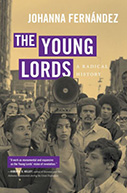The Young Lords: A Radical History

Author: Johanna Fernández
Publisher: Durham, NC: University of North Carolina Press, 2020. 480p.
Reviewer: Andrés Torres | February 2021
East Harlem and the South Bronx, two of the most distressed neighborhoods of New York City, produced an extraordinary outburst of grassroots political radicalism over the course of three pivotal years in American history. The emergence of the militant Young Lords, young Puerto Rican (and some African American) activists of poor and working-class backgrounds, shocked the political establishment and altered perceptions of civil rights and Black Power protests. The Young Lords (the label encompasses the two phases of the groups’ early history: Young Lords Organization and Young Lords Party) effected at least a dozen consecutive actions between 1969 and 1971, directing the community’s anger and frustration with systemic oppression directly at the “establishment.” A demand for respect and a passionate caring for their people moved the Young Lords to act on Ernesto “Che” Guevara’s precepts: “The true revolutionary is guided by great feelings of love” and “Let’s be realistic. Let’s do the impossible!”
Johanna Fernández’s The Young Lords: A Radical History is the definitive work on this political organization and tells the fascinating story with rich detail and narrative drama. In eleven chapters the author documents the groups’ early gang beginnings, its transformation into a media-savvy, community-based socialist organization that employed dramatic, attention-grabbing actions, and how it came to its ultimate demise. These activists confronted race and class inequality and linked local problems to international crises and American foreign policy. They employed a variety of bold and sometimes outlandish actions that ranged from urban guerilla-style interventions of a few days to lengthy, highly planned occupations. Fernández places in historical context New York City’s health care, social welfare, education, and criminal justice systems to demonstrate how city institutions had kept poor people in vulnerable and depressed conditions. Her research is based on interviews with former members (more than are available in any previous work), multiple media and documentary accounts, and archival records, including those of COINTELPRO that were released after a long Freedom of Information Law request and a court battle.
Several chapters in this 480-page volume bear the title of key actions taken by the Young Lords, i.e., “The Garbage Offensive”, “The Lead Offensive”, “The Church Offensive”, and “The Lincoln Hospital Offensive”. This allows Fernandez to delve deeply into the specifics of each event in chronological order, documenting efforts to elevate community control and enact reform, the group’s direct confrontations with police, and muckraking journalism efforts. The author also describes engagement with other advocacy groups and the enactment of sophisticated coalition politics. Fernandez’s history integrates substantial material on the original Young Lord’s Chicago chapter, explaining how it briefly joined with its New York City counterpart. Although the author suggests activity in cities throughout the Puerto Rican Diaspora, she gives few details of community organizing beyond the New York City-Chicago nexus.
Fernandez’s discussion of the group’s theoretical positions on internal colonialism, self-determination, and revolutionary nationalism are informative, as are questions of racial and gender identity. The Young Lord perspective challenged all Americans “to step outside their United States-centered and narrow grasp of race and identity” (p. 269) and female members challenged patriarchy internally, for example, overturning statement favoring “revolutionary machismo,” and externally, with nuanced critiques of white feminist positions on abortion and reproductive rights (see Morales, 2016). The Young Lords were distinct from previous political efforts in four important ways: the organization 1) was the first radical political collectivity to engage and mobilize second-generation Puerto Ricans; 2) proudly embraced the African component in Boricua history, culture and identity; 3) elevated, despite internal resistance, the role of women within radical activism; 4) and held that the most marginalized should be at the forefront of a movement’s concerns and leadership. Entering the 1970s, the Young Lords were the entity that acted on these ideas in a systematic way. Fernández’s political analysis tends to favor the “radical” side of Young Lord politics, but she is careful to note the community service programs embodied in the call to “Serve the People”, and that grassroots organizing is the necessary prelude to changing political consciousness.
The book is a laudatory treatment but does not refrain from pointing out the Young Lords’ flaws and missteps. Toward the end of 1970, the militants’ armed occupation of a church seemed a step to far. The action ended without fatalities, but disenchantment arose among both community residents and members. The blistering pace of activism began to subside. The Young Lords gradually fell victim to intense political in-fighting, much of it revolving around the dominance of centralized leadership, a push for rapid expansion, and questions as to organizational purpose. By 1974, interrogation and physical torture of members accused of being “enemies of the people”, rendered the organization dysfunctional (pp. 371-373). Fernández concludes with descriptions of FBI penetration of the leadership. The spirit of love and compassion for the people that inspired the beginnings had given way to self-destruction and a painful demise.
As a participant in the political struggles of these times this reviewer would have appreciated more discussion of the larger Puerto Rican movement and the afterlife of the Young Lords, particularly coverage of the Puerto Rican Socialist Party and El Comité-MINP (Puerto Rican National Left Movement). These and other organizations continued to actively organize well into the 1980s, with important coalitional efforts involving former Young Lord activists (see Velázquez, Rivera and Torres, 2021). The current volume would be enhanced by telling the story of major campaigns such as the Save Hostos movement, the fightback against the mid-1970s austerity regime during the NYC fiscal Crisis, the National Day of Solidarity with Puerto Rico, and the Bicentennial without Colonies mobilizations. Additional coverage might include the final liberation of the Nationalist Prisoners, the Vieques Solidarity work, and forays into electoral politics. These struggles mobilized tens of thousands of Puerto Ricans, Latinos, and other supporters, and exhibit the vibrancy that characterized the Puerto Rican movement well into the 1980s. Without these references, readers might falsely assume that the Puerto Rican Left disappeared with the end of Young Lord activism.
I highly recommend this book for readers interested in U.S. social movement history. Fernández presents a lively narrative of an iconic organization. The story brims with exciting episodes, life stories of the main protagonists, vital lessons from grassroots organizing, and cautionary notes for today’s activists. It reminds us that authentic movements for change begin with a deep love for and commitment to the oppressed. Losing this focus will lead revolutionaries astray; what is achieved in times of passionate and selfless commitment can leave a lasting legacy.
References
Morales, Iris. Through the Eyes of Rebel Women: The Young Lords, 1969-1976. New York: Red Sugarcane Press, Inc. 2016.
Velázquez, José E., Carmen Vivian Rivera, and Andrés Torres, eds. Revolution Around the Corner: Voices from the Puerto Rican Socialist Party in the United States. Philadelphia: Temple University Press, 2021.
Andrés Torres is retired Distinguished Lecturer, Lehman College, City University of New York.


